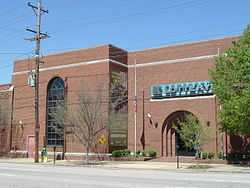Kentucky Lottery

The Kentucky Lottery, consisting of various games of chance, is a government-regulated form of gambling. The Lottery began in April 1989 after a November 1988 vote in which over 60% of voters cast ballots in favor of it.[1] On April 4, 1989, ticket sales began with first day sales of over $5 million for the two available instant games. The first two games were scratch-off tickets, Beginner's Luck ($1) and Kentucky Derby Dreamstakes ($2).[1] The minimum age to play is 18.
History
The Lottery was a highly debated topic in the gubernatorial race of 1987. Wallace G. Wilkinson, who went on to become governor, touted the introduction of a lottery in a heavily funded campaign that ended up being one of the biggest gubernatorial victories in Kentucky history.
As the incumbent Lieutenant Governor, Steve Beshear opposed the lottery in the 1987 race. Ironically, 20 years later, Beshear became Governor-Elect after running on a platform in support of legalized gambling in Kentucky in the 2007 race against Ernie Fletcher.
Pick 3
Pick 3 is drawn 13 times weekly (one drawing Sundays). Prices, prizes, and options very. A 50¢ straight bet can win $300.
Pick 4
Pick 4 is also drawn 13 times weekly. Prices, prizes, and options vary. The maximum prize is $2,500 on a 50¢ straight ticket.
Cash Ball (with Kicker)
Kentucky Cash Ball is drawn daily, except Sundays. Cash Ball uses a 4+1 matrix (Mega Millions and Powerball each use a 5+1 matrix). Cash Ball draws four numbers from 1 through 33, followed by the Cash Ball (numbered 1 through 31). Players can choose: two games for $1, with a top prize of $100,000; or $1 per game, for a top prize of $200,000. Additionally, Cash Ball has a Kicker option; players can wager an additional 50 cents to win $5,000, or $1 to win $10,000.
3 Line Lotto (former game)
The 3 Line Lotto numbers were drawn via random number generator (RNG) Tuesdays and Fridays at 10pm ET; the game had a 6/39 matrix. Players got three lines of six numbers in each $2 game. Its minimum jackpot was $100,000, won by matching all six numbers in any of the three lines. Players won by matching enough numbers in any of the three lines and/or matching their 18 numbers against the 6 drawn.
The final 3 Line Lotto drawing was be February 10, 2012; it was replaced by 5 Card Cash, a poker-themed game, which also is $2 per play and drawn by RNG. (A similar game had been offered in Delaware.) 5 Card Cash is a draw game where players can win instantly if the five "cards" make up a ranked poker hand.)
Decades of Dollars (4 lotteries)
Kentucky, Georgia, and Virginia launched Decades of Dollars on January 30, 2011; its first drawing was February 3. (Arkansas joined on May 3.) Decades of Dollars is drawn Mondays and Thursdays; it replaced Win for Life in Kentucky, while Georgia left WfL in 2012.
Unlike WfL, where winners automatically received annuity payments, Decades of Dollars winners can choose between cash ($4,000,000) and 30 equal yearly payments totaling $7,500,000. The top-prize liability is $10,000,000 cash.
Powerball (44 lotteries)
Since 1991, Kentucky has been a member of the Multi-State Lottery Association (MUSL) which is best known for Powerball; the game began in 1992. Powerball's jackpots begin at $20 million; it is drawn Wednesday and Saturday nights. On October 13, 2009 the Mega Millions consortium and MUSL reached an agreement in principle to cross-sell Mega Millions and Powerball in US lottery jurisdictions. Jackpot winners in Powerball can choose cash in lieu of the yearly payments.
Mega Millions (44 lotteries)
Kentucky was among those joining Mega Millions on January 31, 2010. As in Powerball, jackpot winners can choose the [[present value|cash option]].
Other Kentucky Lottery games
- Scratch-offs (ticket prices $1 to $20)
References
- ↑ 1.0 1.1 David H. Eaton (September 2000). "Kentucky Lottery". Murray State University, College of Business and Public Affairs. Archived from the original on 2007-09-28. Retrieved 2007-06-15.
External links
| ||||||||